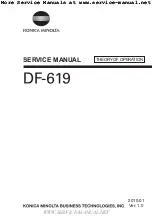
8
2.3 Wire length calculation
1. Slacken the backstay and/or the cap shrouds as much as possible, but make sure that no rigging screws are
unscrewed so far that the threads are no longer visible ”on the inside” of the rigging screw body. Ideally the
forestay setting should not be adjusted. However, if there is insufficient adjustment in the backstay, and the
forestay has a rigging screw, this can be adjusted as well. Just make sure to mark the thread with tape before
adjusting.
2. Pull the top of the mast forward using the genoa or spinnaker halyard. Secure the halyard using a ”D”
shackle or tie the halyard to a strong deck fitting. For safety reasons, do not use any halyard snap shackles.
Secure the halyard tail after the halyard has been tensioned.
3. Go up the mast. Connect a free halyard to the forestay. Then detach the forestay and lower it using the free
halyard. Bring the stay down and place it on a flat surface. If the forestay rigging screw was slackened,
adjust it back to the tape mark.
4. Measure the forestay length (FL) with just enough tension to keep the forestay straight on the ground.
Forestay length (FL) is the distance between the hole in the swaged top terminal and the hole in whatever
lower part that was attached directly to the hole in the chain plate. Enter the measurement
into ”Table 1” below, in the row marked FL.
Table 1: Calculation of forestay wire cutting length
Your
forestay
Example
(204S/Ø8)
with rigging screw
50% extended
FL
Existing forestay length (FL), including rigging screw (See Fig. 2.4.a)
16.243
T
Deduction for lower terminal:
-
- 175
H
If links or extra toggles are to be used, deduct this length (H) from FL.
(See table 6.7).
-
- 0
WL
Cutting measurement. The new forestay wire is to be marked at this point.
(For stays with swaged stud, WL equals the length of the finished stay as
shown in fig 2.4.a and NOT the cutting length)
=
= 16.068
WIRE
Without rigging screw:
With rigging screw:
204S
Ø6 mm wire: 80 mm (3 5/32”)
Ø7 mm wire: 80 mm (3 5/32”)
Ø8 mm wire: 90 mm (3 35/64”)
Ø6 mm wire: 165 mm (6 1/2”)
Ø7 mm wire: 165 mm (6 1/2”)
Ø8 mm wire: 175 mm (6 57/64”)
304S
Ø8 mm wire: 100 mm (3 15/16”)
Ø10mm wire: 100 mm (3 15/16”)
Ø8 mm wire: 200 mm (7 7/8”)
Ø10 mm wire: 205 mm (8 5/64”)
If a Sta-lok terminal (with or without rigging screw) is included, the wire is supplied over-length. The wire has
a swaged eye terminal on one end while the other end is open (= without terminal). If your Furlex is supplied
with a fixed-length forestay, with a swaged eye on one end and a swaged stud in the other end, skip this part
and go directly to 2.4. The same apply for rod stays.
If a stud-terminated stay is to be manufactured by a local rigger it is important to note that WL in this case
equals the length of the finished stay, from eye to end of stud, as shown in fig. 2.4.a. WL is calculated in table 1.
Before assembly, an over-length wire (for Stalok) must be marked and finally cut to the correct length to fit the
boat’s actual forestay length. To find out the correct measurement, follow the steps below. If the mast is not
stepped, you can jump directly to step 4.
You can use the FURLEX CALCULATOR on our web site. Go directly to the calculator by
scanning the QR-code with your mobile device or visit www.seldenmast.com.
ROD
Without rigging screw:
With rigging screw:
204S
Rod -8: 80 mm (3 5/32”)
Rod -10: 80 mm (3 5/32”)
Rod -12: 90 mm (3 35/64”)
Rod -15: 90 mm (3 35/64”)
Rod -8: 165 mm (6 1/2”)
Rod -10: 165 mm (6 1/2”)
Rod -12: 175 mm (6 57/64”)
Rod -15: 175 mm (6 57/64”)
304S
Rod -15: 100 mm (3 15/16”)
Rod -17: 100 mm (3 15/16”)
Rod -22: 100 mm (3 15/16”)
Rod -15: 200 mm (7 7/8”)
Rod -17: 205 mm (8 5/64”)
Rod -22: 205 mm (8 5/64”)









































